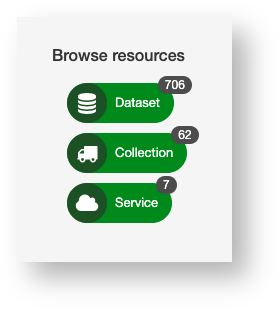This section provides a basic overview of how to search and browse the Data Catalogue (https://geonetwork.nci.org.au/) for datasets, collections and related services at NCI.

Searching the catalogue
A standard 'search' bar function enables free-text search of all resource record titles and abstracts fields in the catalogue. This can be used from the catalogue home page or by selecting the search icon in the upper left menu.

Data collections are hosted within unique project codes at NCI. If you already know the project code that hosts the data you would like to access, this can be a useful way to directly search the catalogue. |
Browsing the catalogue
Browse by topic
The 'browse by topic' option uses the ISO 19115 Topic Category standard. This approach is most useful for high-level browsing of our geospatial data collections. For non-geospatial collections the 'browse by resource' or direct search is recommended.

Please note in large collections (100s - 1000s+ datasets) the catalogue will only contain high-level information at sub-collection levels. |
Browse by resourceAside from browsing by topics, there are several types of resources you can browse by: - Dataset records contain more detailed information about data which are uniform and consistent so as to be programmed. In large collections with a high number of datasets these records may represent a 'sub-collection' - an intermediate record to group datasets that contain the datasets. Where possible the individual datasets are linked as 'child' records.
- Collection is the highest in the hierarchy of data groupings at NCI and can be good for high-level browsing. These records will contain information relevant to all the datasets or data products within a collection. Each collection record links to sub-collection and/or dataset specific records under the 'Associated Records' section of the record.
- Service records contain information about a data service provided by NCI. These records will link to background information about the service and can be used when citing data access, systems or environments at NCI.
|

|
|

